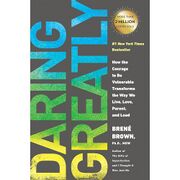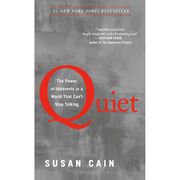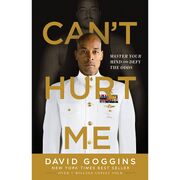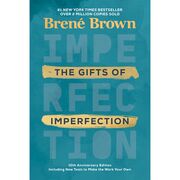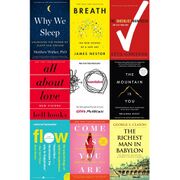The Mountain Is You
🍎 Healthy brain food
"Becoming the best version of yourself is your natural inheritance."
— Brianna Wiest, The mountain is you (2020)
Introduction
| The Mountain Is You | |
|---|---|
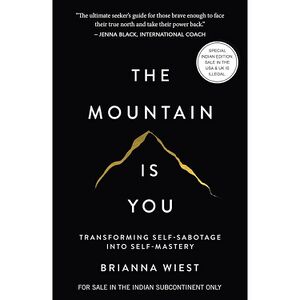 | |
| Full title | The Mountain Is You: Transforming Self-Sabotage Into Self-Mastery |
| Author | Brianna Wiest |
| Language | English |
| Subject | Self-sabotage; Emotional intelligence; Personal development |
| Genre | Nonfiction; Self-help |
| Publisher | Thought Catalog Books |
Publication date | 1 June 2020 |
| Publication place | United States |
| Media type | Print (paperback); e-book; audiobook |
| Pages | 241 |
| ISBN | 978-1-949759-22-8 |
| Goodreads rating | 4.1/5 (as of 6 November 2025) |
| Website | shopcatalog.com |
📘 The Mountain Is You is a self-help book by Brianna Wiest that explains why people self-sabotage and how to convert those patterns into self-mastery by building emotional intelligence and acting with intention, using the mountain as its central metaphor.[1] It was first published by Thought Catalog Books in 2020.[2] The book is structured as seven chapters that move from identifying triggers and developing emotional skills to releasing the past and designing a new future.[3] Since publication, the audiobook has repeatedly appeared on the Associated Press’s Apple Books Nonfiction Audiobooks Top 10, including a No. 1 placement on 4 June 2024.[4] A German translation was published by Piper on 1 December 2022.[5]
Chapter summary
This outline follows the Thought Catalog Books paperback first edition (2020; ISBN 978-1-949759-22-8; 241 pages).[2][1]
🗻 1 – The Mountain Is You. At a trailhead before sunrise, a lone hiker studies the switchbacks on a paper map, checks the weather window, and starts a slow, steady ascent as cold air bites and breath fogs. The climb quickly reveals that the steepest part is not the grade but the voice that wants to turn back at the first stretch of loose rock. This mountain walk becomes a working image: progress comes from choosing the next solid foothold, not from staring at the summit. It distinguishes between external obstacles and the inner patterns—perfectionism, indecision, and fear of visibility—that make the same hill feel higher every time. Practical tools include naming feelings with precision, journaling around recurring triggers, and setting micro-commitments that can be finished in minutes. The emphasis stays on steady exposure to manageable discomfort, which builds confidence the way altitude is gained—one switchback at a time. It treats lapses as information, not failure, so momentum is preserved while the route is adjusted. What looks like resistance is often a protective strategy built to keep things familiar; clarity about needs makes room for better strategies that still protect but no longer stall. By training attention, regulating emotion in small doses, and aligning actions with long-term aims, the “mountain” outside becomes a map of the one within—and climbable.
🚫 2 – There's No Such Thing as Self-Sabotage. Late afternoon in an office, a calendar alert for the gym pops up, gets snoozed, and disappears as a snack and a scrolling break take its place; the day ends with relief and a small ache of regret. The pattern repeats because the behavior works on contact: it lowers stress, avoids potential embarrassment, and preserves energy for a tired brain. The loop is reframed as self-protection rather than self-attack: every so-called “bad” choice is solving a problem the chooser actually feels. Competing goals—comfort and growth—create a tug-of-war that the nervous system resolves by choosing the safest, most familiar path. The practical move is to surface the payoff explicitly (“What does this give me right now?”), then upgrade it with a cleaner alternative—rest scheduled on purpose, a shorter session that still counts, or a supportive environment that removes easy exits. Clear if–then rules and visible prep (shoes by the door, bag packed, ride arranged) replace vague intention with friction that favors the better choice. Progress comes from honoring the need behind the behavior while changing the means of meeting it, not from shaming the part that wants relief. Misalignment—not malice—drives the loop: short-term soothing wins because it answers a real signal faster than a distant goal. Change sticks when the long-term aim feels safer and more immediate than the old relief, so the same protective impulse starts working for, rather than against, the climb.
🎯 3 – Your Triggers Are the Guides to Your Freedom. On a weekday commute, a phone buzzes with “We need to talk,” and the body reacts before the mind—tight chest, shallow breath, a rush of worst-case images. The scene shows how a present cue can light up stored associations so quickly that it feels like danger, not memory. Treat these flashes as data points and keep a simple trigger log that notes time, place, people involved, body sensations, the story that appeared, and the first impulse. Separate primary emotions (fear, sadness) from secondary reactions (defensiveness, perfectionism) that arrive faster but carry less truth. A short pause—label the feeling, identify the unmet need, choose the next smallest useful action—keeps the spiral from taking over. Rehearsing new responses in low-stakes moments, preparing one-sentence boundaries ahead of time, and clarifying the immediate, smallest consequence all reduce the charge. When the same cue repeats, the record makes patterns obvious and suggests where to adjust the environment or expectations. Over time, the once-alarming message becomes a neutral signal because the response is practiced and the need is met cleanly. Ultimately, triggers point to places where self-protection is outdated and growth is due, so curiosity works better than shame. Change follows as exposure and meaning shift together: naming, small corrective moves, and better boundaries teach the nervous system that the present is safer than the past.
🧠 4 – Building Emotional Intelligence. In a Tuesday one-on-one, blunt feedback lands—face warms, jaw tightens, and an urge to justify rises—yet a brief check-in turns the heat down enough to ask clarifying questions and take notes. This everyday stressor yields a practical toolkit for emotional intelligence as a trainable set of skills rather than a fixed trait. It begins with noticing: plain-language labels and quick body scans (head, throat, chest, gut) to track signal strength before it hardens into behavior. It moves to regulation: breathing evenly, stepping away briefly when flooded, and using reappraisal to swap “always/never” stories for specific, testable claims. Decision tools include implementation intentions (“When X happens, I will do Y”), pre-commitments that make the desired action the easiest one, and small, scheduled reps that turn coping into capacity. Communication focuses on needs and limits—what is acceptable, by when, and under what conditions—paired with repair when mistakes happen. The approach also stresses environment design: preparing the next day’s priorities, removing obvious lures, and arranging supportive friction that slows reflexive choices. Recovery basics—sleep, food, movement, sunlight—are framed as non-negotiable inputs that keep emotional range available. As these practices stack, feedback no longer threatens identity; it becomes raw material for learning. Emotions are information to work with rather than commands to obey, which clears a path to self-mastery. Skill under pressure—naming, regulating, and speaking clearly—turns the same stressors into different choices so the mountain shrinks to the size of the next step.
🕊️ 5 – Releasing the Past. On a quiet Sunday afternoon, a reader clears a spare-room closet, sets a small box of old letters and ticket stubs on the carpet, and feels a familiar drop in the stomach before lifting the lid. The exercise becomes structured: a notebook open to two columns—“what happened” and “what I made it mean”—and a short, unsent letter that names losses, thanks, and boundaries. A timer keeps each memory brief so the day doesn’t collapse into rumination, and a simple ritual—tearing up what no longer belongs and keeping one photo that still matters—closes each round. The process is framed as grief work and identity repair: separating responsibility from regret, naming where apology or repair is appropriate, and letting the rest end without more self-punishment. When reminders still sting, the plan is to shrink exposure, replace cues where possible, and practice new stories aloud until they feel truer than the old ones. Sleep, food, and movement are scaffolding so emotional swings don’t decide the meaning of the past. Over several weeks, the same triggers lose their voltage because the body learns there is no emergency attached to them anymore. Releasing is an action, not a feeling; because clinging to yesterday siphons energy from today, repetitive, compassionate updating—rehearsed boundaries, small rituals, and cleaner interpretations—stops feeding the loop. Then the mountain behind you stops casting a shadow on the one you’re climbing now.
🌱 6 – Building a New Future. On a Monday evening at the kitchen table, a blank monthly calendar, a stack of index cards, and a simple checklist become a design lab for the next season. One card names a direction in plain words, another lists the first three visible steps, and a third records incentives you’ll actually feel—a call with a friend after the hard task, a walk outside before the next block of focus. The schedule is built around anchors already in the day—after coffee, before email, right after commuting—so the new behaviors piggyback on cues that don’t fail. Visible prep does most of the heavy lifting: shoes by the door, the document template open, ingredients chopped the night before. A weekly review captures “done” items, snags, and one adjustment for the next seven days, turning course-correction into routine rather than drama. Guardrails—no late-night scrolling, a set stop time, and one small non-negotiable per morning—keep the plan within human limits. Progress is measured by reps, not streaks, so missed days don’t erase momentum. Over time, identity shifts from “trying” to “being” because actions are consistent at small scales where identity is built. A future is constructed by constraints and cues more than by motivation, so design beats willpower. It sticks through repetition in stable contexts—short, easy starts that grow with capacity—until the better path becomes the default line up the mountain.
🧗 7 – From Self-Sabotage to Self-Mastery. At sunrise on a familiar trail, the same hiker who once turned back at the scree moves steadily, checks footing without panic, and pauses at marked cairns to review the route. A pocket-sized card holds the essentials: three values in plain words, two boundaries you keep even when tired, and one question to ask before any big yes. A weekly audit—triggers noticed, repairs made, help requested—keeps the system honest without slipping into perfectionism. Feedback becomes fuel: what hurt last week becomes a rehearsal this week, and the next attempt is smaller, sooner, and easier to start. Tools from earlier chapters now work together: naming and logging triggers, regulating in real time, closing open loops from the past, and designing environments that make the right choice obvious. Trust grows because promises to yourself are sized to be kept, and each kept promise raises the ceiling for the next one. Slips are treated as signals about capacity or clarity, not character, so adjustments happen quickly instead of spiraling into avoidance. Mastery here isn’t a finish line but a practiced stance—calm under pressure, clear on limits, generous with second tries. Self-sabotage dissolves when protection and progress stop competing; consistent alignment between what you value, what you plan, and what you do at the smallest unit of time makes that possible. That alignment turns the climb into a path you can walk every day.
Background & reception
🖋️ Author & writing. Brianna Wiest is a personal-growth author and columnist whose books include 101 Essays That Will Change The Way You Think and When You’re Ready, This Is How You Heal.[6] She has published widely with Thought Catalog, which also publishes her books through its imprint Thought Catalog Books.[7] In September 2022, Thought Catalog reported that Wiest had sold 1 million copies across her books.[8] The Mountain Is You appeared in 2020 under Thought Catalog Books (paperback, 241 pages; ISBN 978-1-949759-22-8).[2] An unabridged audiobook narrated by Stacey Glemboski was released the same year.[9] The book’s method foregrounds emotional intelligence and reframing self-sabotage, using the mountain as a through-line metaphor for doing internal work.[1] Its chapters move from interpreting triggers to skill-building, releasing the past, and planning a new future.[10]
📈 Commercial reception. The audiobook has charted repeatedly on the Associated Press’s weekly Apple Books Nonfiction Audiobooks lists—No. 1 on 4 June 2024,[11] and additional placements such as No. 8 on 12 November 2024 and No. 4 on 16 January 2024.[12][13] The publisher also lists broad translation availability—about 40 languages—on its catalog page (e.g., German, French, Portuguese, Russian, Thai, and Vietnamese).[1] A German edition was issued by Piper on 1 December 2022.[14]
👍 Praise. Inc. highlighted the book as one of five picks to improve leadership mindset, calling Wiest’s approach “realistic” and recommending it as “an exercise in harm reduction rather than a recipe for perfection.”[15] Entrepreneur featured it among 12 bestselling confidence books, noting that it argues compellingly that “people’s biggest obstacle is often themselves.”[16] Oprah Daily described Wiest as a “celebrated author” whose books—including The Mountain Is You—“have inspired millions.”[17]
👎 Criticism. A clinical review by a licensed therapist at Release Counseling praised some insights but argued that much of the messaging felt “uni-directional/causational,” noted “referencing of clinical information without any citations,” and found parts of the trauma discussion “potentially dangerous.”[18] A long-form reader review observed that early chapters are “chock full of motivational notes” and felt “the presentation is lacking.”[19] Another reviewer wrote that it “reads more like an essay than a digestible guide.”[20]
🌍 Impact & adoption. The title appears on London Business School’s “Wellbeing Guide” list of e-books and audiobooks for wellbeing.[21] Boston University’s School of Public Health includes it on the Activist Lab Reading List.[22] James Madison University’s HR “Balanced Dukes” wellness resources also recommend the book.[23]
Related content & more
YouTube videos
CapSach articles
Enjoyed this page?
📚If this page The Mountain Is You inspired or helped you today, a small coffee helps us keep creating and sharing more. Your support truly matters.👏
References
- ↑ 1.0 1.1 1.2 1.3 "The Mountain Is You: Transforming Self-Sabotage Into Self Mastery". Shop Catalog. Thought Catalog Books. Retrieved 21 October 2025.
- ↑ 2.0 2.1 2.2 "The Mountain Is You: Transforming Self-Sabotage Into Self-Mastery". WorldCat. OCLC. Retrieved 6 November 2025.
- ↑ Wiest, Brianna (1 June 2020). The Mountain Is You: Transforming Self-Sabotage Into Self-Mastery. Thought Catalog Books. ISBN 978-1-949759-22-8.
- ↑ "US-Audiobooks-Top-10". AP News. The Associated Press. 4 June 2024. Retrieved 21 October 2025.
- ↑ "The Mountain Is You. Wie du Selbstsabotage erkennen und überwinden kannst". Piper Verlag. Piper Verlag. 1 December 2022. Retrieved 21 October 2025.
- ↑ "Brianna Wiest". Brianna Wiest. Brianna Wiest. Retrieved 21 October 2025.
- ↑ "Brianna Wiest". Thought Catalog. The Thought & Expression Company. Retrieved 21 October 2025.
- ↑ "International Best-Selling Author Brianna Wiest On What It Takes To Sell 1 Million Copies". Thought Catalog. The Thought & Expression Company. 4 September 2022. Retrieved 21 October 2025.
- ↑ "The Mountain Is You (OverDrive audiobook record)". Lafayette Public Library (Marmot Library Network). Marmot Library Network. Retrieved 21 October 2025.
- ↑ Wiest, Brianna (1 June 2020). The Mountain Is You: Transforming Self-Sabotage Into Self-Mastery. Thought Catalog Books. ISBN 978-1-949759-22-8.
- ↑ "US-Audiobooks-Top-10". AP News. The Associated Press. 4 June 2024. Retrieved 21 October 2025.
- ↑ "US-Apple-Books-Top-10". AP News. The Associated Press. 12 November 2024. Retrieved 21 October 2025.
- ↑ "US-Audiobooks-Top-10". AP News. The Associated Press. 16 January 2024. Retrieved 21 October 2025.
- ↑ "The Mountain Is You. Wie du Selbstsabotage erkennen und überwinden kannst". Piper Verlag. Piper Verlag. 1 December 2022. Retrieved 21 October 2025.
- ↑ "5 Professional Development Books to Help Improve Your Leadership Mindset". Inc. Mansueto Ventures. 11 November 2022. Retrieved 21 October 2025.
- ↑ "Need More Confidence? These 12 Bestselling Books Will Help Improve Your Self-Esteem". Entrepreneur. Entrepreneur Media, Inc. 17 July 2025. Retrieved 21 October 2025.
- ↑ "Read This to Get Unstuck". Oprah Daily. Hearst Magazines. 27 February 2025. Retrieved 21 October 2025.
- ↑ "The Mountain Is You: Transforming Self-Sabotage into Self-Mastery (Clinical Book Review)". Release Counseling, PLLC. Release Counseling, PLLC. 28 February 2025. Retrieved 21 October 2025.
- ↑ "Transforming Self-Sabotage Into Self-Mastery, By Brianna Wiest (Review)". Written by Marlene. Marlene Beaulieu. 25 January 2022. Retrieved 21 October 2025.
- ↑ "Book Review; The Mountain Is You by Brianna Wiest". Notes by Thalia. Notes by Thalia. 11 December 2023. Retrieved 21 October 2025.
- ↑ "Audio & e-books – Wellbeing Guide". Information Services and Technology. London Business School. Retrieved 21 October 2025.
- ↑ "Activist Lab Reading List". Boston University School of Public Health. Boston University. Retrieved 21 October 2025.
- ↑ "Reflections on Wellness". James Madison University. James Madison University. Retrieved 21 October 2025.

